From blogger Thomas Swick:


 Today’s Washington Post featured a Q&A, “Post critic Michael Dirda turns a page: Dirda discusses the life of a critic, and his decision for a change of pace after 30 years of weekly columns,” in which John Updike merited a brief mention.
Today’s Washington Post featured a Q&A, “Post critic Michael Dirda turns a page: Dirda discusses the life of a critic, and his decision for a change of pace after 30 years of weekly columns,” in which John Updike merited a brief mention.
Asked if he has a favorite instance of when one of his reviews led to correspondence with the book’s author, Dirda responded, “In general, I avoided getting to know authors I admired because then I’d have to recuse myself from reviewing their books. Still, I counted James Salter and Tom Disch as good friends, was something of a gossipy pen pal with A.S. Byatt, and enjoyed many long telephone conversations with Angela Carter. Among the best six or seven hours of my adult life were those I spent talking books and writers with Guy Davenport at his home in Lexington, Kentucky. I was also gobsmacked when John Updike sent me a two-page letter complimenting me about my memoir, An Open Book.
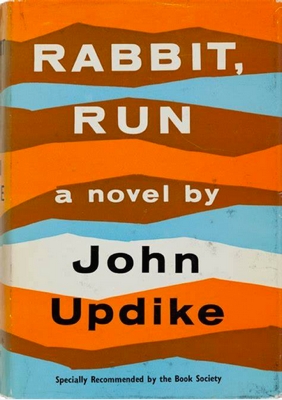
First U.K. Edition
The “about” tab says it all: “The concept of Colin’s Review is pretty self-explanatory. My name is Colin, and I review things. So, why should you care? Professional criticism is a dying industry. Ask any journalist or newspaper staff-writer and they’ll unfortunately tell you the same thing. However, there still exists a large contingency of readers who long for the golden era when criticism itself was just as artful as the topics the authors were reviewing. That’s what I strive to provide on this blog.”
So far he’s only reviewed four books (and Updike might be cringing somewhere to discover that Philip Roth’s Sabbath’s Theater merited an A while Rabbit, Run was awarded an A-), but Colin seems insightful, somewhat bold, and quite readable. In his review, after summarizing Updike’s first Rabbit novel in two sentences, Colin writes,
“It makes for a very funny premise, and when told through Updike’s extremely poetic and occasionally profound style, it makes for a very compelling read. After all, the masculine urge for escape is relatable to everyone. Or, rather, Updike’s such a talented writer that Rabbit’s masculine impulses are easy to empathize with. The further he self-destructs, the more human he becomes.
“Then again, Rabbit isn’t exactly the most likable protagonist . . . . Watching him constantly take advantage of those around him would be quite exhausting if it wasn’t for Updike’s wit and clarity. Not to mention the book’s present tense P.O.V., which keeps Rabbit’s cycle of assholery refreshing despite its repetition—an uncomfortable and entertaining read.
“Back in 1960, Rabbit, Run provided a fresh perspective: a window into the soul of American men disillusioned with the middle-class WASP lifestyle, searching for spirituality but lacking religion, obsessed with sex yet scared of commitment, desperate for meaning in a seemingly meaningless world. Admirable cowards, self-righteous fools.”
Colin notes that Updike had such an “immense” influence that “thousands of similar characters” have “taken up Rabbit’s running-away-from-family mantle. From American Pastoral to Cosmopolis to Five Easy Pieces, there’s no shortage of problematic white male protagonists. Then again, I can’t blame Updike for a half-century of imitators.”
The brisk review is made even brisker with sections on “Further Reading,” “Stray Observations (including Spoilers),” and “Quotes from Rabbit, Run.”
 Updike Society member Lang Zimmerman was reading Salman Rushdie’s Knife: Meditations After an Attempted Murder (Random House, 2024) when he came upon a second-chapter account of the birth of the PEN America World Voices Festival:
Updike Society member Lang Zimmerman was reading Salman Rushdie’s Knife: Meditations After an Attempted Murder (Random House, 2024) when he came upon a second-chapter account of the birth of the PEN America World Voices Festival:
Rushdie wrote, “I’ll just say that if Norman Mailer hadn’t been president of PEN back in 1986—if he hadn’t raised a ton of money and invited a glittering array of the world’s greatest writers to New York City for that legendary Congress at which Günter Grass and Saul Bellow got angry with each other about poverty in the Bronx, and John Updike used the little blue mailboxes of America as a metaphor of freedom and his coziness irritated a substantial segment of the audience, and Cynthia Ozick accused the American ex-chancellor Bruno Kreisky (a Jew himself) of anti-Semitism because he had met with Yasser Arafat, and Grace Paley got angry with Norman for putting too few women on the panels, and Nadine Gordimer and Susan Sontag disagreed with Grace because ‘literature is not an equal opportunity employer’ . . . .”
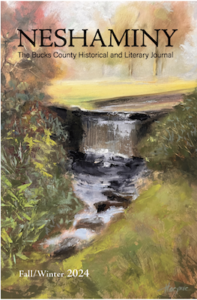 Jeff Werner, of Patch, writes that the editors of Neshaminy: The Bucks County Historical and Literary Journal nominated two essays for The Pushcart Prizes, as literary magazines are allowed to do. One, by Lee Bigelow Davis and Melissa D. Sullivan, was on “Operation ’64: A Matter of Civic Pride.” The other was an essay by Don Swaim: “John Updike—One Walks by Faith, and One Writes by Faith.”
Jeff Werner, of Patch, writes that the editors of Neshaminy: The Bucks County Historical and Literary Journal nominated two essays for The Pushcart Prizes, as literary magazines are allowed to do. One, by Lee Bigelow Davis and Melissa D. Sullivan, was on “Operation ’64: A Matter of Civic Pride.” The other was an essay by Don Swaim: “John Updike—One Walks by Faith, and One Writes by Faith.”
Swaim’s essay was published in the Fall/Winter 2024 issue of Neshamany: The Bucks County Historical and Literary Journal.
Writer Clyde Haberman posted on social media yesterday that the death at age 92 of André Soltner, “the great chef who presided over Lutece in New York,” reminded him of a lunch he had there with John Updike.
“In 1996 I interviewed John Updike there, a restaurant he chose because it was near his publisher, Knopf. ‘There was sort of a symbiosis between the Knopf editorial board and Lutece,’ Updike said. Then he added, ‘I’ve never felt comfortable in here. I feel gourmet food is sort of wasted on me.'”
In “At Lunch With/John Updike; On Reading, Writing and Rabbit,” which appeared in The New York Times on March 6, 1996, Haberman wrote, “A sandwich and a glass of cranberry juice will do for lunch when [Updike] is at home, on 11 isolated acres in Beverly Farms, Mass., about 25 miles north of Boston. At this point, Mr. Updike said, he has to watch his waistline almost as much as his language.
“‘There’s no disguising the fact that a writer’s life is a sedentary one and prone to incessant snacking if you work at home,’ he said. ‘The little break of going down to get another oatmeal cookie is almost irresistible. So I try to make up for the cookies by not eating much at lunch.’
“Even when he was a boy in Shillington, Pa., outside the working-class town of Reading, literature and food converged. ‘I was a great peanut-butter lover from childhood on,’ he recalled. ‘The way I used to read was, we had an old sofa in the house, and I’m make a sandwich consisting of peanut butter and raisins. You’d eat one of those while you read John Dickson Carr or some other mystery writer, or James Thurber of Robert Benchley. In that way, many a happy afternoon went by.'”
Despite Updike’s talk of watching his caloric intake, Haberman wrote, “Let it be noted that he held up fine under the gustatory strain of Lutece, polishing off a serving of grouper after a cup of pumpkin soup and a puff pastry of sweetbreads and spinach. He did draw the line at dessert.”
In his 1-19-25 social media post, Haberman remarked, “That lunch with Updike . . . was one of those times when I enjoyed myself thoroughly and marveled that I actually got paid for such moments. I felt the same after interviewing Umberto Eco in Bologna a few years earlier.”
Could John Updike be responsible for, or at least on the cutting edge of a cultural shift toward individualism? English columnist and writer Sarah Ditum was inclined to think so. Born roughly 50 years after Updike, Ditum wrote in unHerd that Harry Angstrom’s problem was “the typical problem of a 26-year-old Western man living in 1959, when John Updike’s novel Rabbit, Run is set.” In the late 1950s, she wrote, “making the passage from youth to adulthood in your twenties was not merely possible—it was compulsory. In a culture that was tentatively embracing personal freedom, (marriage, a job, and a first child at 23) could feel more like prison than possibility.”
 Ditum reminded readers of the impetus behind Updike’s writing of the novel: “Jack Kerouac’s On the Road came out in 1957, and without reading it, I resented its apparent injunction to cut loose; Rabbit, Run was meant to be a realistic demonstration of what happens when a young American man goes on the road—the people left behind get hurt. There was no painless dropping out of the Fifties’ fraying but still tight social weave.”
Ditum reminded readers of the impetus behind Updike’s writing of the novel: “Jack Kerouac’s On the Road came out in 1957, and without reading it, I resented its apparent injunction to cut loose; Rabbit, Run was meant to be a realistic demonstration of what happens when a young American man goes on the road—the people left behind get hurt. There was no painless dropping out of the Fifties’ fraying but still tight social weave.”
Rabbit’s run, Ditum suggested, was “less a rebellion, more a rush towards the new kind of conformity, scratched out against the great dominating influence of mass-media but nonetheless shaped by it. The moment Rabbit decides to make his escape is probably when he gets home to see his wife slumped in front of a children’s TV show” and “Rabbit is appalled at the banality. . . . His drive towards freedom is soundtracked by the radio.”
“It’s a commonplace that the Fifties invented the teenager, but really the teenager was only a side-product of the decade’s greater creation: the individual in lifelong pursuit of self-realization. An age of personal freedom, carved against the backdrop of screens that declared how a person should be: mass media defined a mean reality, and taught its consumers how to want the things that would mark them as an individual like everybody else. . . . Rabbit’s predicament feels alien now partly because the things that hemmed him in are now almost exotically elusive for young people, but also because the media landscape he’s both repulsed by and defined by doesn’t exist in the same way anymore. At the very least, his disappointing wife would have been scrolling TikTok as well as watching television; Rabbit would probably have been listening to podcasts.”
Bottom line? “The rush to individualism that Rabbit embodied has turned everyone back into a version of him. The TV host’s message to Rabbit—”know yourself”—becomes its inverse: be knowable to the world. And by being knowable, buyable. The consumer and the consumable in one perfect whole.”
 Chase Replogle, pastor of Bent Oak Church in Springfield, Mo., posted a chapter excerpt that didn’t make the final cut of his book, A Sharp Compassion. “I think it still matters, he wrote. “It is taken from the chapter on affirmation and examines how the church has been tempted to avoid what offends.”
Chase Replogle, pastor of Bent Oak Church in Springfield, Mo., posted a chapter excerpt that didn’t make the final cut of his book, A Sharp Compassion. “I think it still matters, he wrote. “It is taken from the chapter on affirmation and examines how the church has been tempted to avoid what offends.”
In comparing Jack Kerouac’s On the Road and John Updike’s Rabbit, Run, which Updike said was written in part as a response to Kerouac’s novel, he notes, “Both novels talk plenty about God. Both raise questions Americans have historically turned to the church to help answer. But Updike alone recognizes the unique temptation the church faces.
“In Updike’s novel, Rabbit genuinely believes that abandoning his family is a kind of spiritual pursuit to find himself. He explains to his pastor, ‘Well I don’t know all this about theology, but I’ll tell you. I do feel, I guess that somewhere behind all this… there’s something that wants me to find it!’ His pastor, Jack Eccles, works tirelessly to reconcile Rabbit with his estranged wife, but Eccles has his own insecurities. He is convinced that his clerical robe and collar rob him of relatability and cost him Rabbit’s genuine respect. He feels he isn’t relevant to Rabbit’s life and interests. His pastoral insecurities lead him to covet Rabbit’s friendship. He imagines that being Rabbit’s friend is an essential prerequisite to leading him back to faith.”
Read the entire excerpt from A Sharp Compassion.
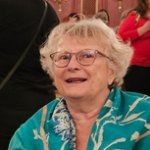 John Updike Society board member Sylvie Mathé was profiled in the series “Persistence of Character — Major interview: Archaeology of a journey” in e-Rea, electronic journal of studies on the English-speaking world. The series, published in French, tracks the breadth of an entire career of distinguished intellectuals, including early influences. An English translation exists in PDF form, but in a file to big to upload and no link to share. Here is the link to a French version online: “Sylvie Mathé: un entre-deux transatlantique (2024).”
John Updike Society board member Sylvie Mathé was profiled in the series “Persistence of Character — Major interview: Archaeology of a journey” in e-Rea, electronic journal of studies on the English-speaking world. The series, published in French, tracks the breadth of an entire career of distinguished intellectuals, including early influences. An English translation exists in PDF form, but in a file to big to upload and no link to share. Here is the link to a French version online: “Sylvie Mathé: un entre-deux transatlantique (2024).”
The interview begins with a list of career milestones:
1951 : Born in Étampes (91)
1968 : Baccalaureate A (Lycée de Pontoise, Val d’Oise)
1968-69 : American Field Service Scholarship (Rock Island, Illinois)
1969-72 : Higher Literature and Première supérieure (Lycée Fénelon, Paris)
1972-76 : École normale supérieure de jeunes filles (ENS-Sèvres)
1973-74 : Lecturer at Oxford (Lady Margaret Hall and St Anne’s)
1975 : Agrégation in English and CAPES in Modern Literature
1975-76, 1977-78 : Visiting Lecturer in French, Yale University
1980 : 3rd cycle thesis : “The everyday and the sacred in the fiction of John Updike” (under the direction of Jacques Cabau, Paris III)
1978-81 : Assistant-Professor in French, Wellesley College
1981-98 : Assistant Professor, then Lecturer, University of Provence
1997 : HDR (under the direction of Claude Fleurdorge, Montpellier III)
1998-2017 : Professor of American Literature, Aix-Marseille University
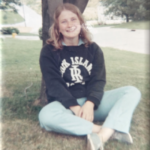 Mathé talks about the full trajectory of her career, including the experience of spending her senior year in high school in Rock Island, Ill. “Compared to my final year in French, the amount of work was nothing like it was, nor the demands of the homework,” she told the interviewer. She shared that her host family was “extremely puritanical,” with the mother “surprised, even horrified, that I had read texts by Hemingway, or Sanctuary by Faulkner…It must be said that 1968 in a small town in Illinois was still the 50s. It had nothing to do with what was happening on campuses at the same time, with women’s lib, demonstrations against the Vietnam War, for civil rights, etc.” In summary, “Let’s say that compared to my final year in French, or my life in France, which was essentially focused on high school, work and success, it was a much more varied life, more entertaining…I was doing things I had never done before: I was caught up in the rhythm, I went to matches according to the football, basketball, baseball seasons,” and she dated, went to parties where there was drinking and marijuana brownies, and was generally inducted into American culture.
Mathé talks about the full trajectory of her career, including the experience of spending her senior year in high school in Rock Island, Ill. “Compared to my final year in French, the amount of work was nothing like it was, nor the demands of the homework,” she told the interviewer. She shared that her host family was “extremely puritanical,” with the mother “surprised, even horrified, that I had read texts by Hemingway, or Sanctuary by Faulkner…It must be said that 1968 in a small town in Illinois was still the 50s. It had nothing to do with what was happening on campuses at the same time, with women’s lib, demonstrations against the Vietnam War, for civil rights, etc.” In summary, “Let’s say that compared to my final year in French, or my life in France, which was essentially focused on high school, work and success, it was a much more varied life, more entertaining…I was doing things I had never done before: I was caught up in the rhythm, I went to matches according to the football, basketball, baseball seasons,” and she dated, went to parties where there was drinking and marijuana brownies, and was generally inducted into American culture.
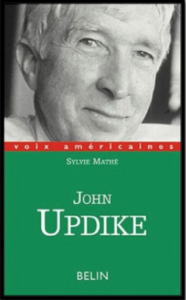 Mathé’s introduction to John Updike came when she went to Oxford and studied “Puritanism in John Updike’s Fiction” with Jeanne-Marie Santraud, “who was the only Americanist at Paris IV.” She would go on to write her master’s thesis on Updike and compose a monograph for the American Voices series edited by Marc Chénetier titled John Updike: Nostalgia for America.
Mathé’s introduction to John Updike came when she went to Oxford and studied “Puritanism in John Updike’s Fiction” with Jeanne-Marie Santraud, “who was the only Americanist at Paris IV.” She would go on to write her master’s thesis on Updike and compose a monograph for the American Voices series edited by Marc Chénetier titled John Updike: Nostalgia for America.
Updike “knew French,” Mathé says. “He came to France for a few months with his family. In several of his novels, for example in Couples, we find a character who prides himself on speaking French. Generally, it’s very funny because he misses the mark.”
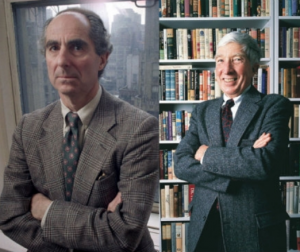 On the American Literature public Facebook group, Milan Milan Stankovic posted a consideration/comparison of two “Great American Writers” whose works offer “profound insights into American society, culture, and individual psychological and individual psychological complexities”: John Updike and Philip Roth.
On the American Literature public Facebook group, Milan Milan Stankovic posted a consideration/comparison of two “Great American Writers” whose works offer “profound insights into American society, culture, and individual psychological and individual psychological complexities”: John Updike and Philip Roth.
Stankovic considers similarities, differences, thematic preoccupations, influences and ideas, and representative works of the two authors.
“Their works remain relevant today. . . ,” Stankovic wrote.